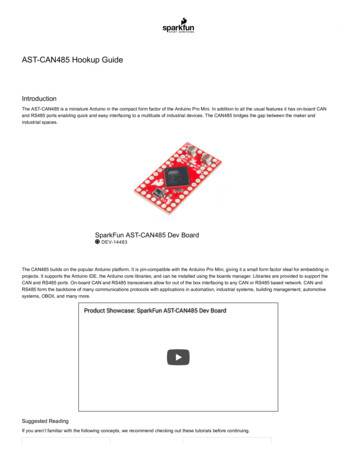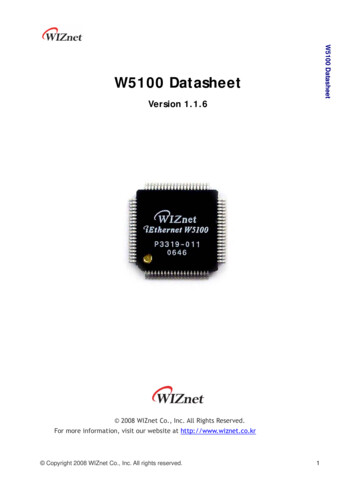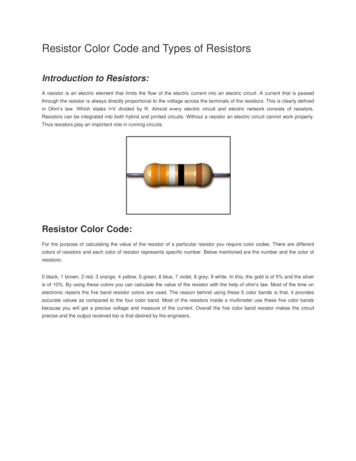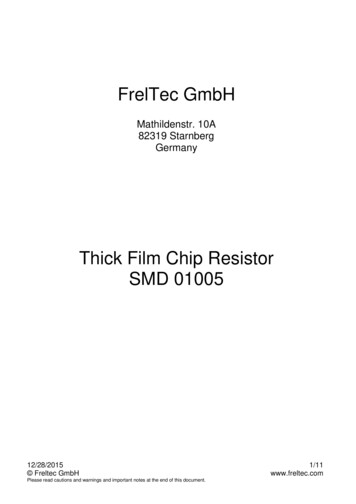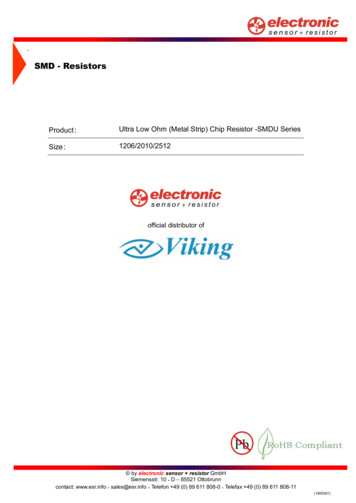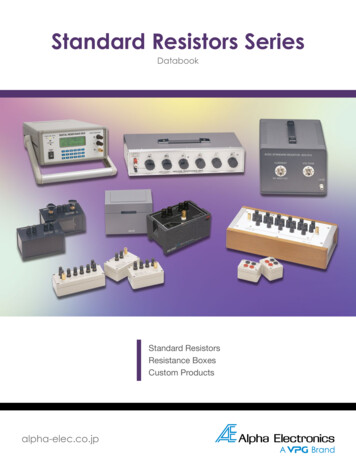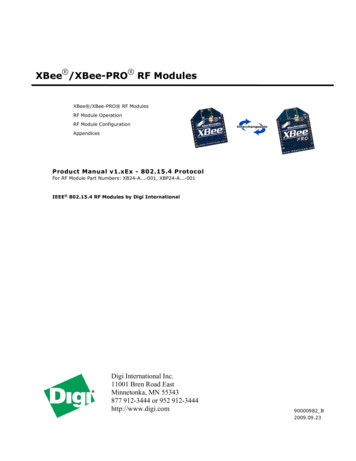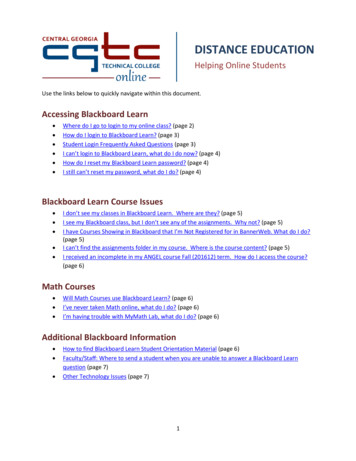
Transcription
Resistors a learn.sparkfun.com tutorialAvailable online at: http://sfe.io/t64ContentsTake a Stance, The Resist StanceResistor BasicsTypes of ResistorsDecoding Resistor MarkingsPower RatingSeries and Parallel ResistorsExample ApplicationsPurchasing ResistorsResources and Going FurtherTake a Stance, The Resist StanceResistors - the most ubiquitous of electronic components. They are a critical piece in just about every circuit. And they play a major role in our favorite equation,Ohm's Law.In this, our pièce de résistance, we'll cover:What is a resistor?!Resistor unitsResistor circuit symbol(s)Resistors in series and parallelDifferent variations of resistorsColor coding decodingSurface mount resistor decodingExample resistor applicationsConsider reading.Some of the concepts in this tutorial build on previous electronics knowledge. Before jumping into this tutorial, consider reading (at least skimming) these first:What is Electricity?Voltage, Current, Resistance, and Ohm's LawWhat is a CircuitSeries vs. Parallel CircuitsHow to Use A Multimeter - Specifically check out the measuring resistance section.Metric PrefixesLooking to get hands-on with resistors?We've got you covered!Page 1 of 16
Resistor Kit - 1/4W (500 total)COM-10969 7.95169Favorited Favorite 168Wish ListResistor 10K Ohm 1/4 Watt PTH - 20 pack (Thick Leads)PRT-14491 1.20Favorited Favorite 11Wish ListPower Resistor Kit - 10W (25 pack)KIT-13053 5.952Favorited Favorite 15Wish ListResistor 330 Ohm 1/4 Watt PTH - 20 pack (Thick Leads)PRT-14490 0.95Favorited Favorite 10Wish ListSee all resistorsPage 2 of 16
Resistor BasicsResistors are electronic components which have a specific, never-changing electrical resistance. The resistor's resistance limits the flow of electrons through acircuit.They are passive components, meaning they only consume power (and can't generate it). Resistors are usually added to circuits where they complementactivecomponents like op-amps, microcontrollers, and other integrated circuits. Commonly resistors are used to limit current,divide voltages, and pull-up I/O lines.Resistor unitsThe electrical resistance of a resistor is measured inohms. The symbol for an ohm is the greek capital-omega: Ω. The (somewhat roundabout) definition of 1Ω isthe resistance between two points where 1 volt (1V) of applied potential energy will push 1 ampere (1A) of current.As SI units go, larger or smaller values of ohms can be matched with a prefix like kilo-, mega-, or giga-, to make large values easier to read. It's very common tosee resistors in the kilohm (kΩ) and megaohm (MΩ) range (much less common to see miliohm (mΩ) resistors). For example, a 4,700Ω resistor is equivalent to a4.7kΩ resistor, and a 5,600,000Ω resistor can be written as 5,600kΩ or (more commonly as) 5.6MΩ.Schematic symbolAll resistors have two terminals, one connection on each end of the resistor. When modeled on a schematic, a resistor will show up as one of these twosymbols:Two common resistor schematic symbols. R1 is an American-style 1kΩ resistor, and R2 is an international-style 47kΩ resistor.The terminals of the resistor are each of the lines extending from the squiggle (or rectangle). Those are what connect to the rest of the circuit.The resistor circuit symbols are usually enhanced with both a resistance value and a name. The value, displayed in ohms, is obviously critical for both evaluatingand actually constructing the circuit. The name of the resistor is usually an R preceding a number. Each resistor in a circuit should have a unique name/number.For example, here's a few resistors in action on a 555 timer circuit:Page 3 of 16
In this circuit, resistors play a key role in setting the frequency of the 555 timer's output. Another resistor (R3) limits the current through an LED.Types of ResistorsResistors come in a variety of shapes and sizes. They might be through-hole or surface-mount. They might be a standard, static resistor, a pack of resistors, or aspecial variable resistor.Termination and MountingResistors will come in one of two termination-types: through-hole or surface-mount. These types of resistors are usually abbreviated as either PTH (platedthrough-hole) or SMD/SMT (surface-mount technology or device).Through-hole resistors come with long, pliable leads which can be stuck into abreadboard or hand-soldered into a prototyping board or printed circuit board(PCB). These resistors are usually more useful in breadboarding, prototyping, or in any case where you'd rather not solder tiny, little 0.6mm-long SMD resistors.The long leads usually require trimming, and these resistors are bound to take up much more space than their surface-mount counterparts.The most common through-hole resistors come in an axial package. The size of an axial resistor is relative to its power rating. A common ½W resistor measuresabout 9.2mm across, while a smaller ¼W resistor is about 6.3mm long.A half-watt (½W) resistor (above) sized up to a quarter-watt (¼W).Surface-mount resistors are usually tiny black rectangles, terminated on either side with even smaller, shiny, silver, conductive edges. These resistors areintended to sit on top of PCBs, where they're soldered onto mating landing pads. Because these resistors are so small, they're usually set into place by a robot,and sent through an oven where solder melts and holds them in place.A tiny 0603 330Ω resistor hovering over shiny George Washington's nose on top of a [U.S. quarter](http://en.wikipedia.org/wiki/Quarter (United States coin).SMD resistors come in standardized sizes; usually either 0805 (0.08" long by 0.05" wide), 0603, or 0402. They're great for mass circuit-board-production, or indesigns where space is a precious commodity. They take a steady, precise hand to manually solder, though!Resistor CompositionPage 4 of 16
Resistors can be constructed out of a variety of materials. Most common, modern resistors are made out of either acarbon, metal, or metal-oxide film. Inthese resistors, a thin film of conductive (though still resistive) material is wrapped in a helix around and covered by an insulating material. Most of the standard,no-frills, through-hole resistors will come in a carbon-film or metal-film composition.Peek inside the guts of a few carbon-film resistors. Resistance values from top to bottom: 27Ω, 330Ω and a 3.3MΩ. Inside the resistor, a carbon film is wrappedaround an insulator. More wraps means a higher resistance. Pretty neat!Other through-hole resistors might be wirewound or made of super-thin metallic foil. These resistors are usually more expensive, higher-end componentsspecifically chosen for their unique characteristics like a higher power-rating, or maximum temperature range.Surface-mount resistors are usually either thick or thin-film variety. Thick-film is usually cheaper but less precise than thin. In both resistor types, a small film ofresistive metal alloy is sandwiched between a ceramic base and glass/epoxy coating, and then connected to the terminating conductive edges.Special Resistor PackagesThere are a variety of other, special-purpose resistors out there. Resistors may come in pre-wired packs of five-or-soresistor arrays. Resistors in these arraysmay share a common pin, or be set up as voltage dividers.An array of five 330Ω resistors, all tied together at one end.Variable Resistors (i.e. Potentiometers)Resistors don't have to be static either. Variable resistors, known asrheostats, are resistors which can be adjusted between a specific range of values. Similar tothe rheostat is the potentiometer. Pots connect two resistors internally, in series, and adjust a center tap between them creating an adjustablevoltage divider.These variable resistors are often used for inputs, like volume knobs, which need to be adjustable.A smattering of potentiometers. From top-left, clockwise: a standard 10k trimpot, 2-axis joystick, softpot, slide pot, classic right-angle, and a breadboard friendly10k trimpot.Decoding Resistor MarkingsThough they may not display their value outright, most resistors are marked to show what their resistance is. PTH resistors use a color-coding system (whichPage 5 of 16
really adds some flair to circuits), and SMD resistors have their own value-marking system.Decoding the Color BandsThrough-hole, axial resistors usually use the color-band system to display their value. Most of these resistors will have four bands of color circling the resistor,though you will also find five band and six band resistors.Four Band ResistorsIn the standard four band resistors, the first two bands indicate thetwo most-significant digits of the resistor's value. The third band is a weight value, whichmultiplies the two significant digits by a power of ten.The final band indicates the tolerance of the resistor. The tolerance explains how much more or less theactual resistance of the resistor can be compared towhat its nominal value is. No resistor is made to perfection, and different manufacturing processes will result in better or worse tolerances. For example, a 1kΩresistor with 5% tolerance could actually be anywhere between 0.95kΩ and 1.05kΩ.How do you tell which band is first and last? The last, tolerance band is often clearly separated from the value bands, and usually it'll either be silver or gold.Five and Six Band ResistorsFive band resistors have a third significant digit band between the first two bands and themultiplier band. Five band resistors also have a wider range oftolerances available.Six band resistors are basically five band resistors with an additional band at the end that indicates the temperature coefficient. This indicates the expectedchange in resistor value as the temperature changes in degrees Celsius. Generally these temperature coefficient values are extremely small, in the ppm range.Decoding Resistor Color BandsWhen decoding the resistor color bands, consult a resistor color code table like the one below. For the first two bands, find that color's corresponding digit value.The 4.7kΩ resistor shown here has color bands of yellow and violet to begin - which have digit values of 4 and 7 (47). The third band of the 4.7kΩ isred, whichindicates that the 47 should be multiplied by 102 (or 100). 47 times 100 is 4,700!4.7kΩ resistor with four color bandsIf you're trying to commit the color band code to memory, a mnemonic device might help. There area handful of (sometimes unsavory) mnemonics out there tohelp remember the resistor color code. A good one, which spells out the difference between black and brown is:"Big brown rabbits often yield great big vocal groans when gingerly snapped."Page 6 of 16
Or, if you remember "ROY G. BIV", subtract the indigo (poor indigo, no one remembers indigo), and add black and brown to the front and gray and white to theback of the classic rainbow color-order.Resistor Color Code TablePage 7 of 16
Having trouble seeing? Click the image for a better view!Resistor Color Code CalculatorIf you'd rather skip the math (we won't judge!), and just use a handy calculator, give one of these a try!Four Band ResistorsBand 1Band 2Band 3Band 4Value 1 (MSV)Value 2WeightToleranceBrown (1)Black (0)Red (100)Gold ( 5%)Resistance: 1 kΩ 5%Five and Six Band ResistorsNote: Calculate your six band resistor here, but be sure to append the temperature coefficient to the final value of the resistor.Band 1Band 2Band 3Page 8 of 16Band 4Band 5
Value 1 (MSV)Brown (1)Value 2Black (0)Value 3Black (0)WeightRed (100)ToleranceGold ( 5%)Resistance: 1 kΩ 5%Decoding Surface-Mount MarkingsSMD resistors, like those in 0603 or 0805 packages, have their own way of displaying their value. There are a few common marking methods you'll see on theseresistors. They'll usually have three to four characters -- numbers or letters -- printed on top of the case.If the three characters you're seeing are all numbers, you're probably looking at an E24 marked resistor. These markings actually share some similarity with thecolor-band system used on the PTH resistors. The first two numbers represent the first two most-significant digits of the value, the last number represents amagnitude.In the above example picture, resistors are marked104, 105, 205, 751, and 754. The resistor marked with 104 should be 100kΩ (10x104), 105 would be 1MΩ(10x105), and 205 is 2MΩ (20x105). 751 is 750Ω (75x101), and 754 is 750kΩ (75x104).Another common coding system is E96, and it's the most cryptic of the bunch. E96 resistors will be marked with three characters -- two numbers at the beginningand a letter at the end. The two numbers tell you the first three digits of the value, by corresponding to one of the not-so-obvious values on this lookup table.Code ValueCode ValueCode ValueCode ValueCode ValueCode 95953161433221048309644538066596976The letter at the end represents a multiplier, matching up to something on this table:Letter MultiplierZLetter MultiplierLetter Multiplier0.001A1D1000Y orR0.01B orH10E10000X or S0.1C100F100000Page 9 of 16
So a 01C resistor is our good friend, 10kΩ (100x100), 01B is 1kΩ (100x10), and 01D is 100kΩ. Those are easy, other codes may not be.85A from the pictureabove is 750Ω (750x1) and 30C is actually 20kΩ.Power RatingThe power rating of a resistor is one of the more hidden values. Nevertheless it can be important, and it's a topic that'll come up when selecting a resistor type.Power is the rate at which energy is transformed into something else. It's calculated by multiplying the voltage difference across two points by the current running
For example, a 4,700Ω resistor is equivalent to a 4.7kΩ resistor, and a 5,600,000Ω resistor can be written as 5,600kΩ or (more commonly as) 5.6MΩ. Schematic symbol All resistors have two terminals, one connection on each end of the resistor. When modeled on a schematic, a resistor will show up as one of these two symbols:

